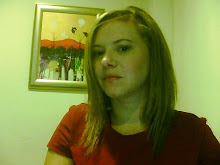I was in as much awe this visit as the last. It's certainly the most imaginative temple I've seen. I can't decide if it represents heaven or hell or both. Or whether it would be more appropriate in Disneyland or a Thai ghost story, or if that's all part of the point. In addition to the glittery white roof trimmings jutting out, some of the most fanciful features are the sculptures. When you get to the entrance you're greeted by hands coming out of the ground seemingly pleading for offerings. Instead of the usual Naga dragon-snakes that guard the entrance of temples in Thailand there are two man-monsters.
If the sculpture and architecture fascinate and frighten, the mural inside the temple are plain unbelievable. The back wall has Chalermchai's depiction of the temptations and desires of this world. Conjoining everything is the demon Mara, who in Buddhist mythology personifies temptation and consistently tries to obstruct the Buddha's quest for enlightenment. The ubiquitous demon manifests itself in many forms: hideous faces, horns, tentacles and other nasty things. My favorite is the snake-turn-gas pipe that crashes into the Twin Towers. Mobile phones, watches, oil, sex, and cars are some of the desirous distractions. There's also a fun cast of characters from pop culture: Java the Hut from Star Wars, Superman, and my personal favorite, Neo from The Matrix!! I assume Neo is a good guy here?? I wish I could have taken pictures (not allowed) but some 'friends' gave me these:
Look into the eye of the evil Mara and what do you see?
The temple testifies to the Thai appreciation of diversity and maintaining tradition while incorporating foreign cultural forms.
We actually got to talk to Chalermchai when he was taking a break from his work. He was very nice to talk to us and tell us a bit about the mural. But we didn't have time to ask any detailed questions, as many people came over to speak to him and get autographs. He did say the mural will be one wall-to-wall piece. Next he plans to paint the side walls of the temple which he says will depict the the shedding of desires, and finish painting the front of the temple with it's beautiful Buddha at the center. So it seems to me he is trying to direct the gaze of the viewer. At first the gaze naturally starts by looking backward at the sensational insanity of the world and all its trappings. After this sensory overload the gaze moves to the side murals that show more and more detachment from the world. Until finally, the gaze can rest on the tranquility of the Buddha.















